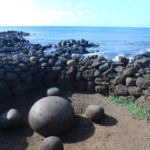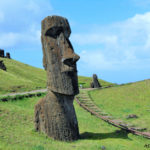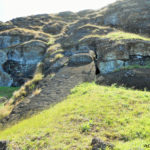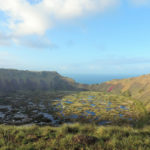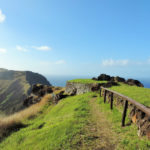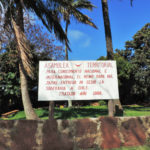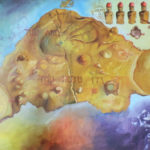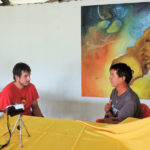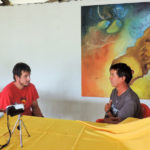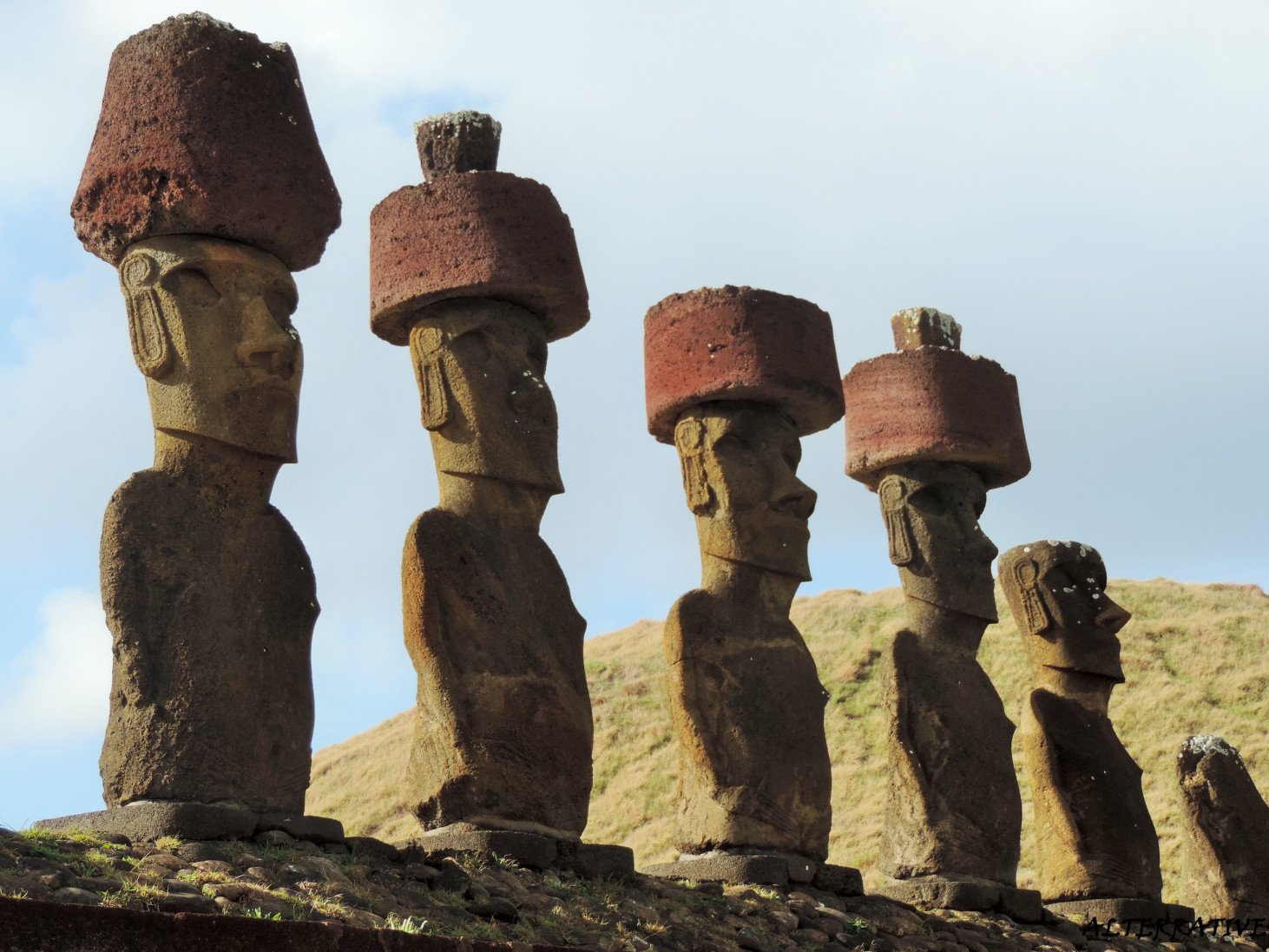
Rapa Nui or Easter Island?
Rapa Nui, better known as Easter Island [1] is usually described as a dot in the middle of the Pacific Ocean, but this time we want to describe it changing perspective. We can start writing something like this: Rapa Nui is the island in the center of the Earth from which the rest of the world is far away. Sounds it different, does not it? After all, things appear differently depending on the point of view you look at them. From Mexico to Peru, from the Maya to the Inca civilizations, the ancient empires built their sacred cities in what they called “the navel of the world”, placing themselves at the center of the Earth. For instance, this is the case of Cuzco, in the twelfth century. The Sun God Inti appointed Manco Capac, the first Inca, to find the navel of the world and to begin there the great Inca civilization. Also according to Rapa Nui foundation legend, the King Hotu Matu’a, moved from Hiva, a Polynesian island, bringing with him a big rock in which it was enclosed Mana, the spiritual power bestowed by the gods, with the duty to place it at the center of the world and to start there a new civilization. The rock is called Te Pito O Te Henua, literally “the navel of the world”, which was probably also the original name of the island. Other documents indicate that the name was Te Kainga, literally “the land”. In any case, both versions express the concept of the centrality of the Rapanui civilization than the rest of the world. Rapa Nui is 117 km2 large, located at 3,601 kilometres east from the American Continent and 2,075 kilometres west from the Pitcairn islands.
Rapa Nui is worldwide known for its Moai, enormous stone statues carved by the population to ask for protection and prosperity to the gods. They were placed on top of the Ahu, stone platforms that served as altars for religious and social ceremonies. The Rapa Nui civilization history began between 600 to 900 AC, when Polynesian settlers arrived bringing with them seeds, plants, animals and everything needed to survive and found a new community. From 1000 up to 1600 AC, the Rapa Nui society flourished and grew, progressively refining the techniques for sculpting and carrying the sacred statues, which weighed several tons. Over time, the moai reached to measure up to 21 m height and the sculptors took almost 2 years of work to complete one of them. From the apex to the decadence, it was a short step: the hard life on the island due to limited resources brought the 18 clans to fight each other. Unfortunately, a great part of Rapanui history is unknown, only few information about what happened are currently available. Part of the material is inaccessible due to the inability to decipher the Rongo Rongo tablets [2], but the main reasons why most of the information have been are lost are the events that led the Rapanui culture almost to disappear over the centuries.
In 1770, two Spanish ships, the San Lorenzo and the Santa Rosalia, sent by Manuel de Amat, viceroy of Peru, landed on Rapa Nui and took it under possession in the name of Charles III of Spain, planting three wooden crosses on the top of Poike montain, one of the three peaks of the island. The island became property of the Spanish kingdom, without any confrontation, meeting or dialogue with the local population, but simply through a unilateral declaration. After the island annexation to the Spanish kingdom, the crown did not send any other expedition to Rapa Nui. The brief Spanish interlude was followed by the arrival of the English explorer James Cook in 1774, who reported that the local population demolished the tree Spanish crosses. In 1786, the French captain Jean Francois de Galaup, Count de Laperouse, landed on island shore and made the first map of the Rapa Nui and In 1816 a Russian expedition led by Otto von Kotzebue finally visited the island.
In 1862, slave traders from Peru reached Rapa Nui deporting and killing approximately 1,500 people, about half of the population at that time. Peru virtually abolished slavery in its territory and therefore it was looking for workforce outside its territorial boundaries. The following year, Peru was forced to release the slaves under the pressure of a strong international advocacy, but only 12 people out of 1,500 Rapanui returned to the island. The rest died due to the hard workload and to diseases like tuberculosis and dysentery. In less than two centuries, the island’s population decreased from 12,000 in the seventeenth century to 111 in 1877.
In 1864, the first Christian missionaries reached Rapa Nui and began a massive campaign of conversion to Christianity, imposing the end of local ceremony rituals as the bird man.
In 1837, the first Chilean ship, the Colo Colo, arrived in Rapa Nui. In 1888, Policarpo Toro headed a second expedition bringing with him the treaty of annexation of the island to Chile. The treaty was written only in Spanish, language unknown on the island at that time, and the King of Rapa Nui signed it without realizing that he was formally annexing his kingdom to the Chilean State. Since 1888, the island became de facto Chilean territory but its population only received Chilean citizenship in 1966. The original treaty has not been revised yet.
In 1897, Chile rented almost the 90% of the island to the private company Scottish Williamson-Balfour, which used Rapa Nui as pasture for its sheep while the inhabitants were confined in Hanga Roa village until 1953. In 1966, the local population regained permission to access to the rest of the island, but because of its strategic position during the cold war years, Rapa Nui fell under the Chilean Navy jurisdiction and used as USA intelligence station.
The possibility to access to the whole territory did not mean that the Rapanui could manage their own land. The inhabitants could use only a small part of the island for agro-pastoral purposes as, since 1973, the territory, declared national park in 1936, is under the control of CONAF (Corporación Nacional Forestal – Forestry National Corporation), private company of the Chilean Ministry of Agriculture with the mandate to protect and manage forests.
In 1980, the Mataveri international airport has been renovated with a consequent growth of tourism and the number of Chilean who wanted to live and do business in Rapa Nui, both factors that exasperated the already delicate situation in relation to land ownership. Part of the local population demanded a community management of the territory, where the most important religious, cultural and historical sites are situated. They were against the privatization policy decided by the Chilean government without any consultation with the Rapanui.
In 2001, the indigenous population founded the Parliament of Rapa Nui, a cultural and political organization created with the aims to recover the ancestral territories, to revise the Treaty of annexation of 1888 and to regulate the influx of immigrants from Chile.
In 2007, a constitutional reform recognized as “special status” to the island that became municipality and province resulting in the election of political office. Autonomy was still very limited because the Rapa Nui province is under the administration of the Valparaiso region, on the mainland, far more than 3,000 kilometres. A partial concession that did not meet the Rapanui needs.
In August 2010, some members of the Hitorangi indigenous clan occupied the resort Hangaroa Eco Village & Spa. According to the occupants, the land was purchased in 1990 by the dictatorial government of Pinochet, violating the agreements between Chile and Rapa Nui and deceptively subtracted to their ancestors. In other areas, the member of Tuko Tuki clan occupied the land claiming its ownership. The protest action ended in violent clashes the Chilean police and 25 occupants injured by rubber bullets. The Inter-American Commission on Human Rights sanctioned Chile government for the violence exercised by the police against the Rapanui population.
When we arrived at the airport in Hanga Roa, a CONAF agent gave us a flyer to inform us that the payment of the Rapa Nui National Park entrance fee was temporarily suspended and that any attempt to collect money fee must be reported to the competent authorities.
Straightaway, we visited the seat of the Parliament of Rapa Nui to better understand what was happening. We met Leviante Araki, president of the Parliament, who explained us better the facts we read about in the newspapers in the days before. On 15th August 2015, Leviante and Mario Tuki, were arrested for impeding the access to the ceremonial site of Orongo to a group of tourists who had not agreed to pay the entrance to the Parliament of Rapa Nui. After the arrest, police officers went to the Parliament to confiscate the tickets and the receipts of payment of the park entrance fee. The representatives of Parliament refused to give them the tickets and the receipts as the police had no formal written authorization from the public prosecutor’s office. In response, the Chilean Ministry of the Interior closed the Parliament of Rapa Nui and deployed police forces in the island to prevent the outbreak of further accidents. Unjustified repression that could cause a new intervention of the Inter – American Commission of Human Rights against the Government in Santiago to protect the population of Rapa Nui.
Leviante explained that Parliament reorganized the management of the land in line with the old division of the island done by the King Hotu Matu’a who assigned a portion to each one of the 18 clans as per Rapanui society structure. Moreover, the Parliament is planning how to improve the self-management of the various archaeological sites. According to the Parliament, there is no reason why an organization as CONAF, whose task is the forests protection, should manage the Rapa Nui archaeological and its earnings, approximately $ 3.6 million (estimated) considering the money collected from the entrance fees payment to the National Park, which had almost 90,000 visitors in 2012.
The Parliament of Rapa Nui asserts that Chile refuses to recognize some indisputable facts: first, the island is actually a colony since it possesses the requirements stated in the resolution n.1514 and n.1541 of the United Nations [3]. Second, the island is a geopolitical entity far more than 4,000 from Chile. Third, the special legal status recognized in the “Ley Pascua” does not meet any Rapanui population needs and requests.
Linked to the independence movement of the other Polynesian islands, the Parliament is constantly in opposition with the Chilean government, which it is demanding independence from. Leviante explains that, despite the big income earned by the Chilean government through the island tourism, services such as hospital, schools and sports facilities are now available in Rapa Nui just because of the strong advocacy of the Parliament of Rapa Nui. The Parliament is also rejecting dozens of proposals from multinational tourist business companies willing to build luxury resorts and hotel that would spoil the natural beauty of the island and alter the delicate social and ecological balance.
The Rapanui population believes that it is time to reclaim their land, to recover their traditions, to speak their language and manage their own territory, but independence does not seem so near. It seems hard to let the navel of the world go, even if everyone see it far away from everything else. History shows that the small Rapa Nui has represented and represents the center of the interests of many. At the moment, the issue of management of archaeological sites is pending. A consultation between Chilean government, CONAF and CODEIPA (Committee for the Development of Easter Island) held on 25th October 2015 decided a joint management of the archaeological sites of Rapa Nui National Park. The aim of the meeting was to “involve the local population in the management of the Rapa Nui national park”. Once again, a hierarchical and paternalistic vision, which does not recognize the centrality and sovereignty of the Rapanui people.
A vision that we hope will change, as we hope that the next meetings will be the starting point of a process that will bring the Rapanui to regain possession of their land and of their roots, the navel of the world civilization.
[1] The name “Easter Island” was given to Rapa Nui by the Dutch explorer Jacob Roggeveen, the first European explorer who landed in Rapa Nui the day of Easter, Sunday of April 5, 1722.
[2] The Rongo Rongo is the writing system of the Rapanui civilization that it is not possible to decipher despite numerous attempts by archaeologists
[3] Resolutions 1514 and 1541 of the UN recognize unconditionally the right to self-determination in the hands of all peoples under colonial rule; according to the formula established by the same resolution in 1541, peoples can freely choose between independence, free association agreement with the homeland or integration in the State administering






